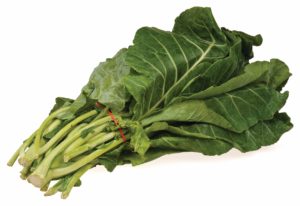Classic Collard Greens
Collard greens are a southern classic and favorite. These leafy vegetables grow in a loose bouquet, unlike their “cousins”, cabbage, that grow in a tight head. Collard greens are ridiculously easy t
Collard greens are a great, healthy, leafy vegetable to add to your diet! They are cholesterol free and low in calories and fat. They are also a great source of vitamin A, vitamin C, vitamin K, folate, calcium, and fiber. Having a high intake of veggies like collard greens can help decrease your risk of obesity, heart disease, and diabetes.
When shopping for collard greens, you should look for greens that are dark green and firm with unwilted leaves. Make sure to always wash your collards under water before eating or cooking them! It is best to store the washed leaves in a plastic bag in the refrigerator. When kept in the fridge, collards will stay fresh for about five days. Collard greens have a mild, almost smoky flavor to them. They are very versatile as they can be sautéed, steamed, braised, or boiled. The smaller the leaves, the milder they will taste and more tender they will be. Depending on how mature or tough the leaves are, collards can take anywhere from 20 minutes to an hour to cook. You will know they are done when they turn bright green! Collard greens pair well with just about any meat, especially pork, potatoes, black eyed peas, red beans, and barbeque. In the south they are traditionally slow cooked with pork and garlic, yum!!!
For your enjoyment, try out a collard greens recipe courtesy of Food Network!
Did You Know?
· Collard greens are part of the Brassica family, being closely related to cabbage, broccoli, and kale.
· If you overcook collard greens, they will emit an unpleasant sulfur smell.
Content courtesy of Florida Department of Agriculture and Consumers Services, UF/IFAS Extension and Food Network.
Information compiled by: Avianna Liuzzo
